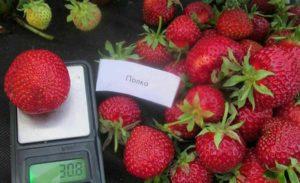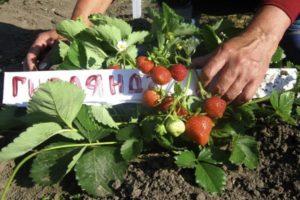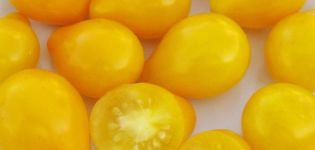Description and characteristics of strawberry varieties Marmalade, cultivation and reproduction
A culture with a similar name should be the favorite of all gardeners. Indeed, the Marmalade strawberry is very popular both in its cultivation and on the market. High yield, resistance to diseases make it unpretentious to care for. And berries cannot be confused with other varieties.
Description and characteristics of strawberry varieties Marmalade
The berries are fully consistent with their name, although outwardly they are similar to other varieties, but the aroma leaves an unforgettable trace behind the Marmalade.
Bushes
Strawberry bushes Marmalade are low, slightly spreading. The dark green foliage is located high above the ground, making harvesting much easier. The inflorescences stretch above the leaves, which is why in the spring, during flowering, the bed seems white. The flowers of the variety have many petals, with a yellow center in the center.
The inflorescences have a thickened stem, which is why they are able to keep large fruits above the ground. This feature is important for strawberries, since the crop will not be susceptible to diseases such as powdery mildew or rot.
The flowering of strawberries of the Marmalade variety is very intense and long-lasting. Antennae on the mother liquor is few.
Berries
Features of Fruit Jelly:
- the weight of some specimens reaches 40 g, but the average weight is 30 g;
- regular conical shape with a blunt tip;
- the color is bright red, the tip is white;
- seeds are yellow, slightly depressed into the pulp;
- strong aroma;
- the taste is excellent, the berries are more sweet, but with a slight sourness.

During ripening, the strawberries turn red together. They are arranged in clusters on the inflorescence. Sometimes the largest berries resemble the splicing of two, there is some roughness. At the stage of technical ripeness, the flesh of the Marmalade becomes dark red, dense and juicy. Thanks to these characteristics, strawberries are well stored and transported over long distances.
Strawberries of the Marmalade variety, the description of which attracts many summer residents, has an excellent presentation and is very much appreciated in the market.
Drought resistance and frost resistance
Varietal strawberries tolerate low temperatures from 0 to -15 degrees. But if the frosts intensify and there is little snow on the garden bed, it requires shelter. This nuance should be taken into account when breaking down the strawberry plantations.
Important! With large snowdrifts in the garden, the Marmalade variety can transfer and -30 FROM.
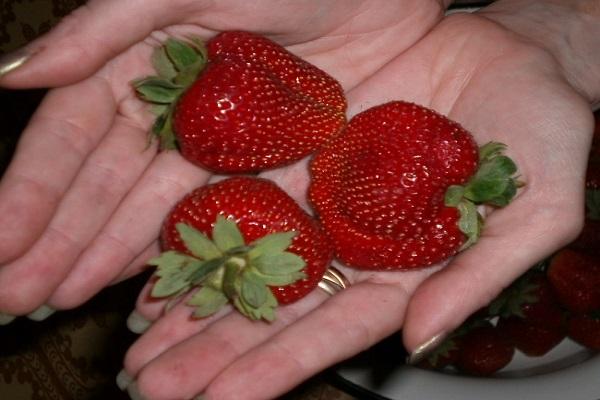
The plant also tolerates drought, but with timely watering. But the scorching rays of the sun can bake the crop, it will become lethargic and flabby. Pouring of fruits will occur faster, which spoils the taste of the berry. It must be remembered that over-watering is also negative for the plant.
Ripening period and yield
Ripening period is average. The first strawberries can be picked in July. During the season, Marmalade is capable of producing up to 1 kg of fruit from one bush. If you follow all the rules of agricultural technology, then the crop can be harvested twice per season.
The greatest returns are observed in the second and third years of cultivation. On an industrial scale, Marmalade strawberries are renewed every 3-4 years, in private garden plots at least once every five years.
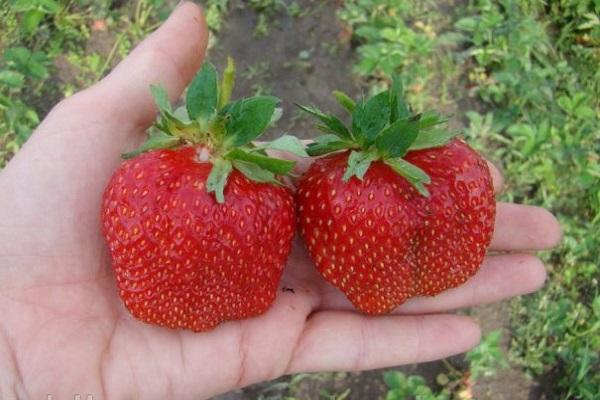
Transportability
Despite the juiciness of the fruit, Marmalade is well transported in paper boxes and wooden boxes with a layer of up to 20 cm. If the berries have green leaves, then the transportation time may increase. In its pure form, the crop can start juice.
Pros and cons of strawberries
Varietal features due to which Marmalade berries are loved by gardeners:
- The fruits are large and sweet with a strong aroma, which is very welcome in cooking.
- High yield of the crop, sometimes up to twice a season, but at the same time requires little attention.
- Unlike other varieties, it tolerates heat and severe frosts perfectly.
- Feels good during transportation.
- The variety is resistant to disease.
But there is always a fly in the ointment:
- deterioration of taste when grown in areas with a continental climate, where unstable weather prevails;
- strawberry Marmalade is demanding on the soil, the acidity should be slightly increased - up to 7 units;
- requires frequent renewal of plantations.
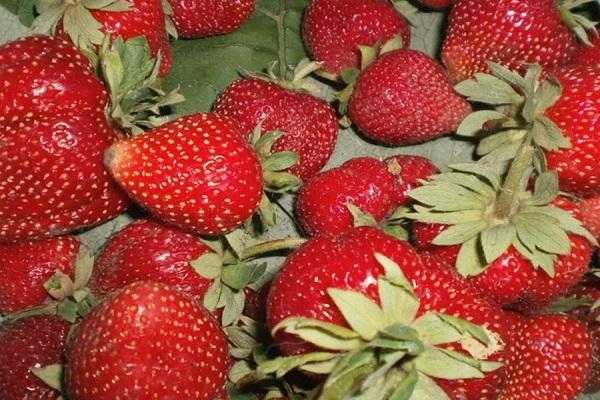
Opinions about strawberries are divided, but the number of gardeners growing them is not decreasing. Strawberries remain one of the most common varieties. A double opinion, most likely, depends on the region, the growing climate, as well as on non-compliance with the rules of agricultural technology.
Nuances of growing berries
To achieve a result when growing berries, you need to make a lot of effort, although agricultural technology does not differ from the rules for growing any variety.
Boarding time
The best time for planting young bushes is the end of August. From August until the onset of severe frosts, there is still a lot of time during which the plant will take over and grow the root system well. Next year, strawberries will give their first harvest.
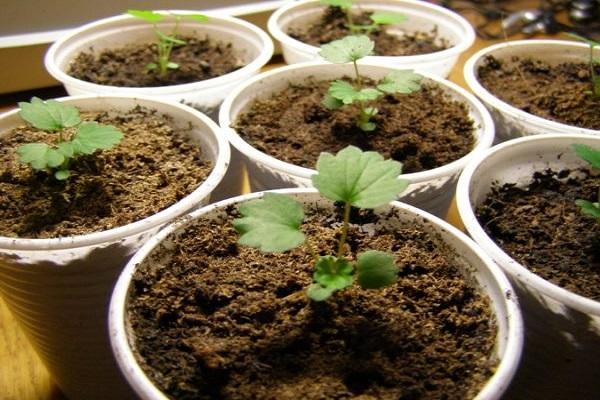
Site selection and preparation
Choosing a plot for strawberries is an important step in cultivation. Lighting, wintering, soil moisture depends on it:
- If the garden has slopes, then it is better to place the garden at the top. A lot of moisture accumulates at the bottom, which has a detrimental effect on the roots of the Marmalade. In addition, there is not enough light in the lowlands. But there is still an advantage: in winter there is a lot of snow, even in a winter with little snow, the berry fields will not have to be covered.
- Strawberries love space. With its lack, the lateral offspring, if they are not circumcised, will thicken the mother liquor. They select a site with neutral or slightly acidic lands.
Strawberries of the Marmalade variety are planted in an open area, where there is sufficient lighting, and there are no trees or bushes nearby. It should not be located near potatoes, eggplants and tomatoes, as viral diseases from vegetable crops can go to the berry. And yet, if there is little snow in winter, you can cover the plantings or put items for snow retention.
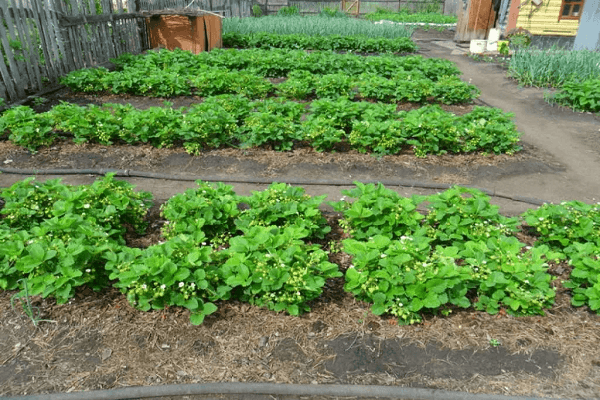
Preparation of planting material
Planting material can be purchased, or you can grow it on your site if you have several pure-bred seedlings. You need to buy them only from trusted distributors or in gardening and nurseries.
Young strawberry bushes Marmalade must be carefully selected:
- They should be free of dry roots and foliage.
- Leaves are bright green with pubescence that looks like a silvery bloom.
- The middle kidney should be thickened.
- The bush is low, not elongated from lack of sun.
- It is better to buy seedlings in containers, their root system is not subject to injury and will quickly take root.
- You should see mustache pieces, about 4 cm.
If strawberry seedlings are grown independently, then caring for them is similar to caring for the mother plant. As the antennae and daughter outlets develop, they are sprinkled with earth on it. This happens in early summer. And at the end of August, they can be cut off, dug up and transplanted to the main bed.

Landing scheme
The planting scheme for varietal strawberries is simple. Leave about 30 cm between adjacent bushes, you can leave more, and leave 20 cm between rows. If the mother plant sits down, then it is better to increase the distance so that there is room for dropping side sockets.
Plant care rules
Care should be carried out according to an established scheme: watering, fertilizing, weeding, loosening, mulching, treatment for diseases and pests.
How to water properly?
The best watering for strawberries is drip irrigation. If it is not possible to equip such humidification, it will have to be done manually. Young seedlings are watered from a watering can from above to wash off the dust from the leaves. When the plant begins to bloom, it is irrigated at the root so as not to wash off the pollen from the flowers.
The frequency of soil moisture depends on weather conditions. It must be remembered here that very moist soil is not suitable for this strawberry variety. Water the Marmalade at least 1 time per week, if required by the land. In the process of ripening, watering is reduced to 1 time in two, three weeks.
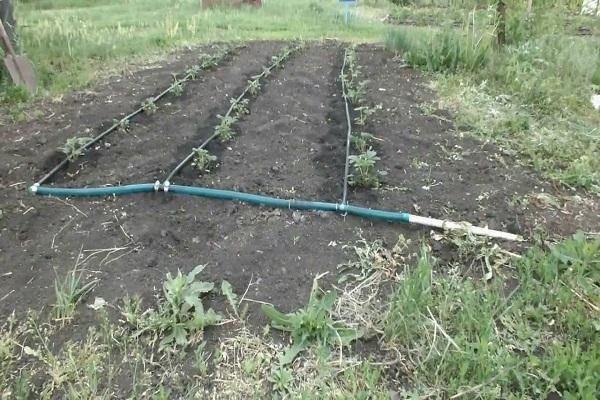
Fertilizer requirements
If the season is dry, in the spring it is required to mulch with rotted humus so that the earth does not crack, and organic elements will enrich the soil depleted since autumn.
| Application period | Type of feeding and dose |
| Immediately after the snow melts and the topsoil thaws, in April | An aqueous solution of manure in a ratio of 1: 6, superphosphate in an amount of 60 g and wood ash about 150 g. Mix everything in ten liters of water |
| Before strawberry bloom, in May | Aqueous urea solution, 30 g per 10 liter bucket of water |
| During the flowering period, in June | Calcium nitrate at the rate of 30 g per 10 liter bucket |
| After harvest, before wintering, in September | Dry phosphate and potash fertilizers - up to 45 g / m2 |
Shelter for the winter
This procedure is pretty straightforward. It is important to remember here not to weed strawberry plantings before hiding so as not to damage the root system before wintering.
As a covering material, mulch in the form of corn trunks and leaves, tops of flowers, straw is suitable. Be sure to put anti-rodent agents under the mulch. Cover with agrofibre or other covering material on top. Any rag will do.

Reproduction
There are several ways to propagate strawberries Marmalade. In any case, varietal characteristics are preserved.
With a mustache
Mustaches are daughter rosettes of strawberries, of which there are up to three or four pieces. It is better to choose the first two stepsons from the mother plant as planting material. By the time of transplantation, they have time to gain strength and take root.
Important! Each offspring should have 3-5 true leaves, and the root collar should be at least 6 mm.
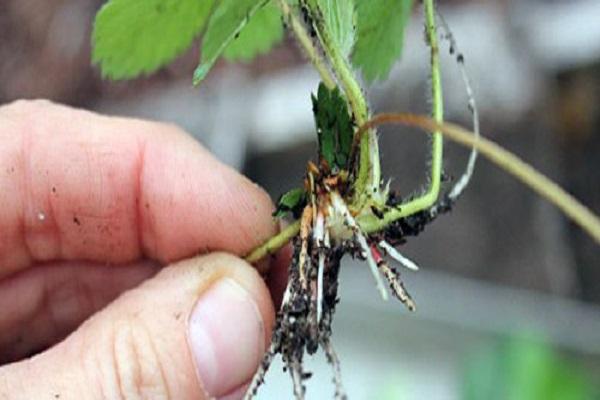
Dividing the bush
The technique is used if there are few antennae on the strawberries or they are of poor quality. They take a three-year-old bush, cut it with a sharp knife into as many parts as there are central buds. It is important that the root is well developed. As a result, you should get up to three new bushes.
Important! The procedure is carried out from spring to the end of summer, so that the roots have time to take root, and the plant gains strength for wintering.
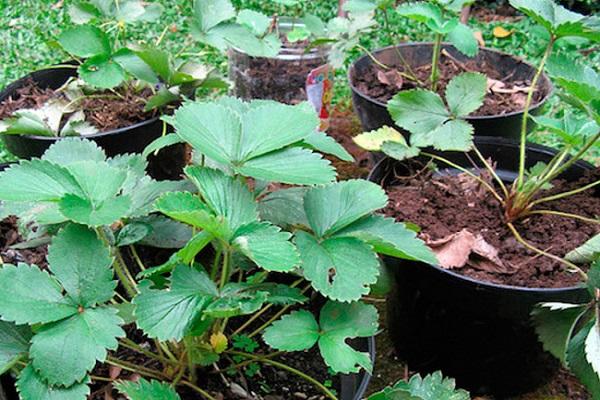
Seeds
A rather laborious way to propagate strawberries. The seeds are best bought in specialized stores. They should be planted in shallow seedling boxes, with the appearance of two pairs of leaves, the seedlings dive into separate containers or cassettes. When a growth of 10 cm is reached, the seedlings are planted in the beds.

Protection against diseases and pests
Strawberry resistance to pests and diseases is relative, they will be in any case. Only timely treatment of the berry with fungicides and insecticides will save the crop from death.
The most common problems on strawberries of the Marmalade variety:
- powdery mildew;
- strawberry mite;
- snails, slugs;
- gray rot;
- white spot.
From folk remedies, effective: wood ash, tobacco dust and garlic solution.
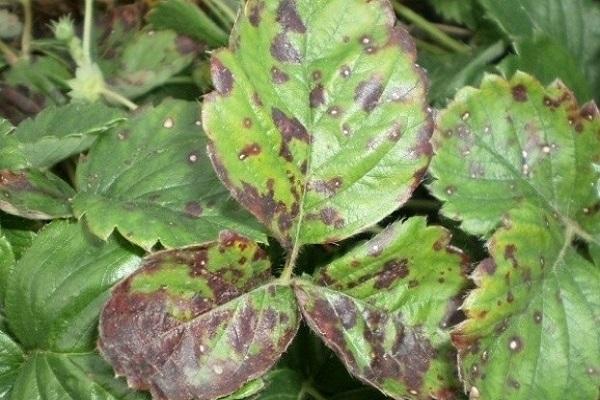
Collection and storage
Strawberry harvesting begins in June with an interval of two days. They are plucked with a stalk so that the berries do not lose their presentation. In this form, they are stored frozen, packaged in small containers. At low temperatures, the berries are kept for more than six months.
Strawberries are stored in the refrigerator at a temperature from 0 to +4 degrees for no more than a week, but subject to heat treatment, in the form of winter preparations (compotes, jams, preserves) - about a year.
Strawberries of the Marmalade variety are loved by many summer residents for their unpretentiousness, but it should be noted that many are not delighted with it. In any case, it is better to have strawberries of various varieties on your site. Indeed, the taste and quality of berries can be affected by weather conditions, which will be better in the future.
